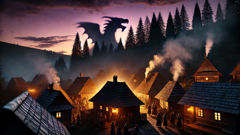Introduction
On the high shoulders of the Carpathians, where the road narrows to a ribbon and the firs lean toward one another like old friends whispering, the villagers spoke the Zmeu’s name in the same breath as caution. The Zmeu was not a simple monster, and the old women who braided wool on long winter afternoons never meant only one thing when they said it; sometimes they meant hunger, sometimes envy, sometimes a storm that would tear the roof from a cottage. They described him as an enormous creature with scales that caught the dying light and eyes like red coals in a cold ash — part dragon, part ogre, and entirely inhuman in manner and appetite. Children were hushed at the sight of a shadow moving wrong across the yard. Young maidens walked home with skirts held high, their hair braided tight, because once a Zmeu set his mind on a thing he took it with a surety that left no room for appeals. Yet the story that grew out of that fear belonged as much to hope as to terror: it was the story of Făt-Frumos, who carried the slow confidence of mountains in his jaw and the nimble mercy of river stones in his hands. He was not born princely; his village had no gilded halls, only a wooden church where icons watched over the same parish for a hundred winters. Still, when the Zmeu came and stole the warm center of the village’s life — a young maiden known for laughing like wind over barley — the people found their courage gathered in his shoulders. This tale follows that taking and the ways both ordinary and wild devised to set things right. It moves through pine-scented passes and river meadows carpeted with marigolds, into the Zmeu’s lair where iron and hunger and loneliness mingle. It travels with Făt-Frumos as he learns that strength alone will not answer every riddle; he must read omens from the pattern of smoke, listen to a nightingale that sings where no nightingale should be, and understand that the world holds bargains both cruel and sacred. Here, tradition meets invention, and the land—steeped in superstition and in stubborn tenderness—shows how a small bright thing can be rescued from a vast, dark maw if a heart will keep its course.
The Riddle of the Missing Maidens and the Zmeu's Hunger
The first winter the Zmeu came with claws that scraped like weather against the mountains, the people blamed strangers and wolves and misfortune. Then a second winter arrived and a girl named Ileana did not come home from the festival. Ileana had hair like spun wheat and a laugh that made the old men look as if they'd remembered a softer time. She danced until moonrise among the circles of villagers, and then, by morning, the cradle beside her mother’s stove was empty of its perfume. They found a shoe by the river and a smear of crimson on the stepping stones where the bank gave way to reed and ice. That shoe, small and embroidered, became proof enough that something monstrous had slipped like a quick shadow through the village that night.

People gathered by the church to pray, and by the inn to argue. Each time a woman told the story of the missing, she added small details that shivered into truth: a song heard from the hillside that had no human voice, a bread basket found upturned with loaves untouched, a wind that smelled of iron. The priest spoke of sin and of repentance; the elders spoke of an old bargain broken between mountain and man. But agreements mean little when hunger is an inheritance. The Zmeu, as the stories drew teeth, had once been a prince of his own kind, turned monstrous by grief or greed — lore sang it either way. He was said to hoard more than gold: keys to streams, the names of wolves, the sleep of newborn lambs. Yet thieves of names are thieves of people, and the Zmeu took what he could not fashion from his lair: daughters, daughters-in-law, anyone who reminded him that warmth could not be won with the clamor of claws.
The theft of Ileana stunned Făt-Frumos into motion. He was not yet a hero, only a youth who had learned to mend nets and sit with his hands folded in patience. Yet grief has a way of making men larger than they imagined; it makes them put their hands to tasks that once seemed beyond them. Făt-Frumos took the trail the shepherds whispered was a path, the one that threaded the mountains like a silver seam. He ferried himself across a river that whispered against its bed and crossed a ridge where stones leaned like old sentries. Along the way he encountered small signs of the Zmeu’s passing: a tree stabbed through with a spear of iron that no man had left, a cave mouth plastered with soot and the smell of roasted meat. More than once the path offered a riddle: a dove with three toes, a stream flowing uphill for a stride, a fox whose tail was braided with string. Each oddity hinted at a rule in the Zmeu’s world, a code that mixed the natural with the enchanted.
Făt-Frumos came upon a shepherd who had lost his wife to the same hunger. The old man taught the youth how to read tracks not simply as shapes in mud but as the intention of the foot: whether the traveler had been hurried, burdened, or keeping a secret. He taught him what the moon says when it skims a rock and how to tell if the wind carries path or decides it is making mischief. From a wandering hag who mended shoes on the crossroad, Făt-Frumos accepted a small object wrapped in linen: a glass bead that caught dark and split it into a dozen tiny moons. "This will show you what is hidden," she said, and when he unrolled the cloth he felt something like cold patience settle in his belly. It might have been superstition; it might have been an old woman's gratitude, or a debt finally paid back. Still, when he followed the bead's glint under a stone and found a scrap of fabric that matched Ileana's embroidery, the proof guided him toward the lair's general direction. Men do not walk into the jaws of what devours without some thread to hold them — whether it is a mother's blessing or a bead that makes the unseen visible — and so he moved by small certainties.
The Zmeu's lair was not a place you expected. It sat in a valley that the map did not want to show: ringed by cliffs where lichens clung like old coins, with a river that ran black and slow along its bed. Trees there kept their needles even in midwinter, and the air tasted of iron and mint and old coins. At the entrance, Făt-Frumos saw the remnants of former captives: a woven belt, a ribbon dyed by pomegranate, the imprint of a small hand on a stone. He lit a torch and the flame shook like a thing persuading the dark to disclose itself. Deeper in, the Zmeu kept a courtyard of trophies. They were not only objects but pieces of lives: a comb carved from bone, a lullaby hummed inside an old jar, a shawl pinned with a rusted brooch. The trophies smelled of soap and salt, of wine and winter. Into this curio trove the Zmeu had crammed stolen laughter and broken vows, and in the center of it all he had built a throne of ribs and iron.
Facing the Zmeu is not only a matter of steel. When Făt-Frumos entered the chamber, the creature rose like a hill split by motion. He had more arms than the laws of men should permit, and his wings were crooked like the promises of faded kings. He smelled of smoke and wild onions. He spoke in a voice that made the floor tremble, as if the earth remembered an ancestor's grief and had decided to announce it. The Zmeu did not hide its hunger. "I take what pleases me," he said; the sound of words seemed to be a shape tasted from other languages. "I collect what people forget to attend to: their vows, their songs, their daughters." Făt-Frumos felt fear as a live thing curling at his throat, but he remembered the girl's laughter and the bead's coolness in his pocket. He knew brute force might break some bones, but the true contest would be for what the Zmeu had stolen beyond flesh — the habit of being feared, the solitude that had become armor.
Conversation followed that was part bargaining and part accusation. The Zmeu spoke of loneliness as if it were a crown. He said that he had once loved and lost and transformed his longing into a habit of taking. He asked Făt-Frumos to trade: a song for a life, a secret for a promise. The youth realized the enemy fed not only on bodies but on being paid attention. He offered tales from the village, the names of children, the smell of freshly cut hay. He argued, he lied when he needed to, he played the small, human tricks that keep cunning company. At a moment when the Zmeu’s attention wandered, Făt-Frumos found Ileana among the trophies, a pale knot of a person with her eyes slo-ken by fear. He could have run then, with the shadow and the bead and the last of his courage, but the Zmeu's hand closed like a falling gate. The fight that followed wasn't a clean clash of steel; it was flaying of will, tugging at the strings that hold habit and breaking them, or replacing them with a new practice: bravery fed by mercy.
Victory, in that chamber of iron and keepsakes, was stubborn and ungainly. The Zmeu did not collapse like a straw hut but crumpled with stories folding back into him, as if the village's remembered songs had been a salt that corroded the rust of him. In the end, it was not only the sword or the bead that did the work. It was the way the people outside remembered the stolen and sang until the mountain could no longer pretend deafness, and the way Făt-Frumos refused to let the Zmeu's loneliness be the last warrant for violence. When he led Ileana from the lair, the dawn found the valley less monstrous and more accountable, as if the world had been made to answer for itself.
They returned to a village that had been hollowed by worry but remained threaded with love. Ileana's mother folded her into a shawl and wept, not only from relief but because the village had regained the word for its own courage. From then on, when the Zmeu’s shadow slid across a ridge, people did not bow to it with the single survival of fear; they met it with songs and with the knowledge that hands, when held together, could be an answer stronger than any single blade. Yet the Zmeu’s hunger, like winter weather, never entirely left; it changed its form. Legends keep their teeth precisely because they continue to teach that courage is an ongoing practice, not a single bright event. This part of the story remembers that lesson and keeps it living in the way villages choose to light their lamps and teach their children to keep watch, not from terror but from respect for how much the mountains ask of those who live beneath them.
Făt-Frumos, The Trials, and the Unraveling of the Zmeu
After Făt-Frumos had led Ileana out of the Zmeu’s court and back into daylight, the hero’s life did not smooth itself into immediate ease. Stories do not end the instant the monster is gone; rather, the rhythm shifts to ask how the village will hold what was recovered. People came to see the youth, offering him bread still warm from the oven and trinkets that were meant as thanks. Mothers pressed warm cloths into his hands and said, "You have warded us." Făt-Frumos nodded, but his answers felt small against the stretch of what had been taken and what had been given. There was also the matter of the Zmeu's ruin: when such a creature loses its center, the world must reconfigure. Rivers that had been kept in place by enchantment might change course, and a mountain’s mood could go from merely stern to dangerously altered. The village gathered, elders and young men and the priest who had once spoken in absolutes, and they mapped what needed mending.

A string of trials followed, not the single combat of a tale told for the market, but a series of smaller reckonings, tests of the village's fiber. Crops that had been under the Zmeu’s pall recovered slowly; some sheep that had grown tacit would not give up their fear. Children born during the Zmeu's stay had a caution braided into their steps and needed to be taught how not to let it harden into always. Făt-Frumos helped where he could. He read vows aloud to those who had been afraid to marry, he shoveled earth into furrows at dawn, and he breathed the easy presence of someone who had refused to let fear be the final authority. He learned that healing often bore the shape of small, ordinary labor: mending fences, naming lost things, teaching the young how to feed a flock without scaring the lambs.
Yet there were remnants of the Zmeu that did not dissolve with his fall. Rumors said he had not perished but simply retreated, that he would return when nights grew long and the old bargains were forgotten. The story of his return became a cautionary tale parents told as the winter nights grew long: keep your hearths clean, keep your promises to the land, remember to honor the mountain with a loaf or a song. Făt-Frumos took this to heart. He traveled for a time beyond his village, through towns where the roads were paved by merchants and their languages tasted different, and he traded the bead the hag had given him for knowledge. An old woman in a market town, who braided herbs into her hair and sold ointments, taught him how to braid not only hair but memory: to take small artifacts and weave them into stories so they would be remembered. That knowledge turned out to be as useful against monsters as any sword; names, once spoken aloud in a web of story, become anchors that keep mischief from returning. Where the Zmeu had once been fed on forgetting and neglect, Făt-Frumos offered remembrance.
A crucial trial came when a traveler from a distant valley arrived with a tale of a Zmeu that had taken not maidens but water. Its thirst had diverted a spring away from a farming community. The people there were dying slowly in their fields as their grain withered and their animals thinned. Făt-Frumos joined a small band who crossed ranges that scraped the sky with their teeth. They found an amphitheater of stone where a dark thing drank perpetually. Unlike the first instance, this Zmeu had learned different tricks; he could charm rocks into closing and could sing a lullaby that made stones forget their place. Făt-Frumos recognized how monstrous hunger adapts to new ways of feeding. So the counter had to learn as well. He and his companions wove songs into the river itself, and in the night they performed them until the water hummed the tune back. It was a long, patient work: song repairs what force cannot; it returns old habits to the world where they once belonged. The people there regained their water. They celebrated not simply a rescue but the return of a tone to their daily lives.
Another test lay in the Zmeu’s domestication of grief. It had made of sorrow a kind of throne. In the Zmeu's former court the stolen songs and calmed laments had settled into a stillness that felt like control. Făt-Frumos had to teach the village how to grieve without letting sorrow become armor for a future predator. He arranged gatherings where people shared their losses aloud, and they answered each loss with small acts of creation: a new rope for the mill, a carved spoon, a painted icon. These gestures were not grand, but they turned emptiness into a vessel that could hold stories, and in holding stories the villagers neutralized a monster's appetite. Repopulating what the Zmeu had taken required imbuing the ordinary with the sacred; ritual and habit became scaffolding that prevented the past from sliding back into monstrous appetite.
There was also a moment of personal reckoning for Făt-Frumos. Ileana, whom he had saved, refused to become a prize in his hands. She was no passive emblem of victory; she was a person who had been tested by a dark place and had to find her own ways back into daylight. For a spell they argued — not bitterly but like people who had traveled separate deserts and discovered different languages. She had learned to move through silence and to measure the weight of words. He learned that rescuing does not conclude with leading someone past the threshold of danger; it continues in the patient work of seeing someone restored to the fullness of life. Ileana took to gathering girls at the river and teaching them songs for keeping wrists steady and hands busy. She kept a small chest of the trophies she had reclaimed, not as proof of conquest but as a classroom of losses that could be learned from. Children would come and listen while she spoke plainly about fear and the ways it can be kept honest.
In the end, the unraveling of the Zmeu was not a single heroic arc but a communal elongation of courage. Villages across the valley adapted the lessons the hero had learned: they repaired what grief had taken, they set small ceremonies to remember what they had almost lost, and they taught their young to be mindful of the mountain's moods. Men and women adopted the practice of leaving a loaf or a knot of thread at the foot of certain trees, a simple vow that the land was owed a recognition. Those rituals were not magic so much as attention; a thing noticed tends to be less likely to be stolen. Across the years the rumor of the Zmeu turned from dread to a warning that asked for maintenance. Făt-Frumos married not in a palace but under the firs, with neighbors bringing simple cakes and icons. The hero’s name softened into a household reference: not a legend pinned under glass but a living habit, a story told on winter nights and at harvest tables so children would learn how to keep their courage from calcifying into fear. The mountains, too, loosened their sternness; they now bore the marks of people who had learned how to live beneath them without being eaten by legend. What remained of the Zmeu was a reminder, a carved shadow in the memory of a people who had been brave enough to reclaim their own lives and gentle enough to share that reclamation with their neighbors.
Conclusion
Years later the story of the Zmeu passed from campfire to classroom and took different shapes with each telling, but the story's bones remained: a creature that once took and a people who learned to resist not only by force but by memory, by ritual, and by gentle acts of repair. Făt-Frumos did not become a legend perched on high for the sake of vanity; he became a man who taught that courage is daily and communal. Ileana taught the children to sing away fear rather than to hide from it, and the village adopted small offerings to the mountain so the Zmeu's hunger would not find an unguarded corner. Folklore keeps both shadow and remedy in view, so that those who hear the tale may learn to read the land's moods and answer them with small, steady attentions. The Zmeu, when he appears in the murmur of elders now, is a reminder: monsters thrive where promises are allowed to wither and where remembrance is neglected. The cure is not merely skill with a blade but the habit of noticing — to name what is missing, to braid it back into community, to make your life an active answer against erasure. That is the practical magic passed down with the tale, and it is why, in villages beneath the Carpathian sweep, people still leave a ribbon at the crossroads and sing a simple melody into the night, not because they expect miracles, but because they know care given small and daily is often enough to keep the dark at bay.













